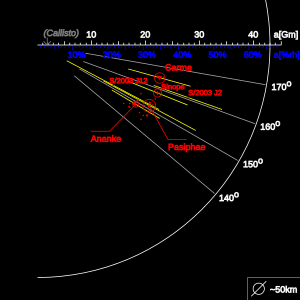Pasiphae (moon)
 Pasiphae photographed by the Haute-Provence Observatory in August 1998 | |
| Discovery[1] | |
|---|---|
| Discovered by | Philibert J. Melotte |
| Discovery site | Royal Observatory, Greenwich |
| Discovery date | 27 January 1908 |
| Designations | |
Designation | Jupiter VIII |
| Pronunciation | /pəˈsɪfeɪ.iː/[2][3] |
Named after | Πασιφάη Pāsiphaē |
| 1908 CJ | |
| Adjectives | Pasiphaëan /ˌpæsɪfeɪˈiːən/[4] |
| Orbital characteristics[5] | |
| Epoch 23 March 2018 (JD 2458200.5) | |
| Observation arc | 110.34 yr (40,303 days) |
| 0.1551422 AU (23,208,940 km) | |
| Eccentricity | 0.6110162 |
| –722.34 d | |
| 259.25505° | |
| 0° 29m 54.18s / day | |
| Inclination | 153.40903° (to ecliptic) |
| 19.11682° | |
| 241.59647° | |
| Satellite of | Jupiter |
| Group | Pasiphae group |
| Physical characteristics | |
Mean diameter | 57.8±0.8 km[6] |
| Mass | 1.72×1017 kg (calculated) |
Mean density | 1.70 g/cm3 (assumed)[7] |
| Albedo | 0.044±0.006[6] |
| 16.9[8] | |
| 10.1[5] | |
Pasiphae
The moon was first spotted on a plate taken at the
Pasiphae did not receive its present name until 1975;[12] before then, it was simply known as Jupiter VIII. It was sometimes called "Poseidon"[13] between 1955 and 1975.
Orbit

Pasiphae orbits Jupiter on a high eccentricity and high inclination retrograde orbit. It gives its name to the
Pasiphae is also known to be in a secular resonance with Jupiter (tying the longitude of its perijove with the longitude of perihelion of Jupiter).[16]
Physical characteristics

With a diameter estimated at 58 km, Pasiphae is the largest retrograde and third largest irregular satellite after Himalia and Elara.
Spectroscopical measurements in infrared indicate that Pasiphae is a spectrally featureless object, consistent with the suspected asteroidal origin of the object. Pasiphae is believed to be a fragment from a captured asteroid along with other Pasiphae group satellites.[17][18]
In the visual spectrum the satellite appears grey (colour indices B-V=0.74, R-V=0.38) similar to C-type asteroids.[19]
See also
- Irregular satellite
References
- ^ .
- ^ Noah Webster (1884). A Practical Dictionary of the English Language.
- ^ "Pasiphae". Dictionary.com Unabridged (Online). n.d.
- ^ Laurent Milesi (2003). James Joyce and the difference of language. p. 149.
- ^ a b "M.P.C. 111777" (PDF). Minor Planet Circular. Minor Planet Center. 25 September 2018.
- ^ S2CID 5834661. 3.
- ISSN 0035-8711.
- ^ Sheppard, Scott. "Scott S. Sheppard - Jupiter Moons". Department of Terrestrial Magnetism. Carnegie Institution for Science. Retrieved 26 November 2020.
- ^ "Planetary Names: Planet and Satellite Names and Discoverers".
- doi:10.1086/121815.
- .
- ^ IAUC 2846: Satellites of Jupiter 7 October 1974 (naming the moon)
- ISBN 0-134-78107-4.
- ISBN 0-521-81808-7, 2004, pp. 263-280
- S2CID 120372170.
- doi:10.1086/382099.
- S2CID 15143844.
- ^ Sheppard, S. S.; and Jewitt, D. C.; An Abundant Population of Small Irregular Satellites Around Jupiter Archived 5 August 2003 at the Wayback Machine, Nature, Vol. 423 (May 2003), pp. 261-263
- , Icarus, Vol. 166 (2003), pp. 33-45
